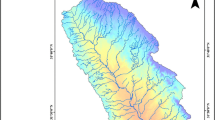Abstract
The area of upper Vaigai river basin covering parts of Madurai and Theni Districts, in Tamil Nadu, faces acute water scarcity and chronically drought prone. The groundwater resources in the area have not been fully exploited. The present investigation has been made to evaluate the potential zones for groundwater targeting using IRS - ID LISS III geocoded data on 1:50,000 scale. The geology, geomorphology, lineament tectonic maps are generated and integrated to evaluate the hydrogeomorphological characteristics of the upper Vaigai river basin and demarcate the groundwater potential zones. A number of geomorphic units have been observed. Out this the more groundwater prospective units are buried pediment medium, buried pediment deep, flood plain, bajada and lineament and intersection of lineaments. Non potential areas like pediment, pediment inselberg, shallow pediment and pediplain were identified.
Similar content being viewed by others
References
Bhattacharrya, A. and Reddy, P.R. (1991). Hydrogeomorphological mapping for groundwater prospects in India using IRS imagery. How to meet the demand of drinking water. In Remote Sensing in Asia and Ocenia-Environmental change and monitoring (ed. Shunji Murai). Asian Association of Remote Sensing Tokyo, Japan.
Department of Space, (1988). Preparation of hydrogeomorphological maps of India on 1:250,000 scale using Satellite Imagery. Project Document, National Technology on Dinking Water, Department of Space, 83p.
Gaile, G.L. and Burt, J.A. (1980). Directional Statictics, concept and techniques in modern geography No. 25, Geo abstracts, Univ. East Anglia, Nkorwish, 39p.
Geological Survey of India, (1978). Know Your District (published), Tamil Nadu and Pondicherry, Geological Survey of India, 1978.
Ghose, R. (1993). Remote sensing for analysis of groundwater availability in an area with long unplanned mining history. Jour. Indian Soc. Remote Sensing, 21(3):119–126.
Gumbel, E.J., Greenwood, J.A. and Durand, D. (1953). The circular normal distribution: Tables and theory. J. Amer. Soc., 18:131–152.
Gupta, A. (1980). Correlation of Landsat and air borne magnetic anomaly data of a part of the Bihar mica belt. Proc. Symp. Remote Sensing in Subsurface Exploration, held on 25 Oct., Bangalore, India, pp. 23–30.
Karanth, K.R., Jeganathan, V., Prakash, V.S. and Saivasa, V. (1992). Pegmatites- A potential source for setting high yielding wells. J. Geol. Soci. India, 39(1):77–81.
Knig, L.C. (1950). The study of the world plain lands: A new approach in geomorphology. Quart. Geol. Soc, London, 106:101–103.
Kumar, A., Tomar, S. and Prasad, L.B. (1999). Analysis of fractures inferred from DBTM and remotely sensed data for groundwater development in Godavari sub-watershed, Giridih, Bihar. Jour. Indian Soc. Remote Sensing, 26(2):105–114.
Mardia, K.V. (1972). Statistics and directional data, Academic Press Ltd, London, 357p.
Pradeep, K.J. (1998). Remote Sensing techniques to the locate groundwater potential zones in upper Urmil river basin, District Chatarpur, Central India. Jour. Indian Soc. Remote Sensing, 26(3):135–147.
Prakash, S.R. and Mishra, D. (1991). Identification of groundwater prospective zones by using remote sensing and geoelectrical methods in and around Saidnagar area, Dakar Block, Jalaum District, U.P. Jour. Indian Soc. Remote Sensing, 21(4):217–227.
Prakash, S. Ravi and Mishra, D. (1993). Identification og groundwater prospectives zones by using remote sensing and geoelectrical methods in and around Saidnagar area, Daker block, Jalaum District, U.P. Jour. Indian Soc. Remote Sensing, 21(4):217–227.
Qureshy, M.N. and Hinze, W.J. (1989). Workshop Overview. Proc. Joint Indo-US Workshop on Regional geophysical lineaments-their tectonic and economic significances, Mem. Geol. Soc. Ind., Bangalore, no. 12:3–10.
Ramesh, Y. (1990). Geomorphic Studies in Upper Gostani River Basin with Speial References to Borra (Karst) Caves Visakapatnam District, A.P., India. Ph.D. Thesis (un published), Andhra University, India, 131p.
Rao, U.R. (1991). Remote sensing for national development. Curr. Sci., 61(3 & 4):121–128.
Ravindran, K.V. and Jeyaram, A. (1997). Groundwater prospects of Shahbad Teshil, Baran District, Eastern Rajasthan: A remote sensing approach. Jour. Indian Soc. Remote Sensing, 25(4):239–246.
Reddy, P.R. (1987). Geological and Geomorphological studies through remote sensing. In special volume of COSTED Remote Sensing Technology for natural Resources.
Sankar, K., Jegatheesan, M.S. and Balasubramanian, A. (1996). Geoelectrical Resistivity Studies in the Kanyakumari District, Tamil Nadu. Jour. of Applied Hydrology vol. IX, nos. 1&2, pp.83–90.
Saraf, A.K. and Choudhary, P.R. (1998). Integrated remote sensing and GIS for groundwater exploration and identification of artificial recharge sites. Int. J. Remote Sensing, 19(10):1825–1841.
Sharma, D. and Jugran, D.K. (1992). Hydrogeomorphological Studies around Pinjaur-Morni-Kala Amb Area, Ambala District (Hariyana) and Sirmour District (Himachala Pradesh). Jour. Indian Society Remote Sensing, 20(4): 187–197.
Sinha, B.K., Kumar, A., Srivastava, D. and Srivastava, S.K. (1990). Integrated approach for demarcating the fracture zone for well site location—A case study near Gumla and Lohardaga, Bihar, Jour. Indian Soc. Remote Sensing, 18(13):1–8.
Sparks, B.W. (1960). Landforms in arid and semi-arid climates. Geomorphology 2nd Ed., Longman Group Ltd., pp.335–341.
Subba Rao, N. (1992). Factors affecting optimum development of groundwaters in crystalline terrain of the Eastern Ghats, Visakhapatnam Area, Andhra Pradesh, India. Jour. Geolo. Soc. India, 40(5):462–467.
Thornbury, W.D. (1990). Principle of Geomorphology. Wiley Eastern Limited, New Delhi, 594p.
Tiwari, A. and Rai, B. (1996). Hydrogeomorphological mapping for groundwater prospecting using Landsat MSS images- A case study of part of Dhanbad District. Jour. Indian Soc. Remote Sensing, 24(4):281–285.
Author information
Authors and Affiliations
About this article
Cite this article
Sankar, K. Evaluation of groundwater potential zones using Remote Sensing data in upper Vaigai river basin, Tamil Nadu, India. J Indian Soc Remote Sens 30, 119–129 (2002). https://doi.org/10.1007/BF02990644
Received:
Accepted:
Issue Date:
DOI: https://doi.org/10.1007/BF02990644




